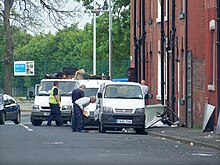Holbeck
[6] The old manor belonged to the priory of the Holy Trinity at York and after the Dissolution of the Monasteries passed to the Darcy and Ingram families.[7] Key factories were: In the mid-19th century Holbeck was one of the most densely populated suburbs of Leeds, described in 1834 as 'one of the most crowded, one of the most filthy, one of the most unpleasant, and one of the most unhealthy villages in the county of York'.[13] Further slum clearance took place in the 1930s, and a workhouse, built by around 1870, was at this time converted into a hostel for the destitute, before being demolished in the 1970s and replaced with a school.[15] The railway station has been demolished, but plans began to be developed in 2014 to convert the track bed (which is currently overgrown with trees and shrubs) into a raised walkway leading directly into Leeds city centre.[17] From 1956 to 2004 Kays Catalogues was the largest employer in Holbeck, acquiring Samuel Driver Ltd in 1956 and taking over Temple Works on Marshall Street, expanding the site in the 1950s and again in 1981.[7] According to Simon Bradley, writing in 2016, The boundaries of Holbeck have moved over time, but my interviewees broadly agree on where it lies: bounded by Leeds City railway station and the River Aire to the North; the M621 to the south; the east perimeter follows Victoria Road, overlooked by Bridgewater Place (known locally as 'The Dalek'); the west is defined by the A643 feeder road joining the M621 to Armley Gyratory.The land where the low-rise flat blocks were has been used for brand-new social housing including four-bedroom family homes to two-bedroom apartments.Three rows of back-to-back terraced homes on Brown Lane-West and Top Moor Side have been demolished and made way for some more social housing, built by Keepmoat.Holbeck is unique in Leeds as an area where many early to mid 19th century industrial buildings survive in an unaltered group within the original street pattern.[9] A proposed 120 feet (37 m) tall sculpture by Antony Gormley, Brick Man, to stand in the triangle between railway lines, was never commissioned, but a 1986 maquette can be seen in Leeds City Art Gallery.In 2014 Leeds Council in conjunction with West Yorkshire Police trialled a managed approach to prostitution which allowed for soliciting and purchasing of sex in a light industrial area in a bid to: After a review in 2016 it was announced that this was to continue indefinitely.



Holbeck, NottinghamshireHolbeck (disambiguation)West YorkshireOS grid referenceMetropolitan boroughCity of LeedsMetropolitan countyRegionYorkshire and the HumberCountryEnglandSovereign statePost townPostcode districtDialling codePoliceAmbulanceYorkshireUK ParliamentLeeds Southinner cityLeeds city centreLS11 postcode districtM621 motorwaysAberfordBeeston and HolbeckLeeds City CouncilLeeds and Liverpool CanalTemple WorksMarshall's MillRiver AireSheepscar BeckOld NorseScandinavianViking Agepriory of the Holy TrinityDissolution of the MonasteriesHarrogateBorthwick Institute for ArchivesUniversity of YorkIndustrial RevolutionJohn MarshallMatthew MurrayRound FoundryMiddleton RailwayTaylor, Wordsworth and CoTower WorksColonel Thomas HardingSlum clearancecholeraHolbeck railway stationviaductVictorian ageHolbeck Working Men's Clublisted buildingsThe Dark ArchesMidland Millsroundhousestrack bedKays Cataloguestownshipcivil parishflood plainLeeds City railway stationBridgewater PlaceBeestonHolbeck Urban Villageback-to-backterracottaLeeds and Bradford RailwayLondon and North Western RailwayAntony GormleyBrick ManLeeds City Art GalleryCommissioners' churchWesleyansKwik Savepost officeStephen ScholeyHenry Rowland MarsdenJohn ScholeyJoseph BlackburnThomas WalkerTed PeateDavid Eccles NicholsAlexander Tom CussonsFrank DennisStan BrogdenIvy BensonHasib HussainVesta VictoriaListed buildings in Leeds (Beeston and Holbeck Ward)Holbeck Viaduct ProjectGENUKIWayback MachinePevsner, NikolausYale University PressA Vision of Britain through Time

